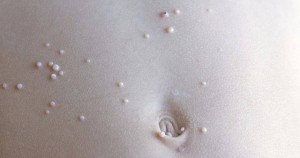Doctors’ Notes
BackMolluscum Contagiosum
You’ve had enough! It started out looking pretty harmless, two or three flesh colored bumps on your child’s skin.They didn’t look too bad, and your child didn’t seem to even notice them, so you let it go. But now it’s been a month, and your child has several more of these bumps that have traveled over various parts of his or her body.
Time to call in the experts! What your child might have is a viral infection called Molluscum Contagiosum.
Mollusca-What?
Now, I know what you’re thinking. It sounds like a cousin to the black plague. But fortunately it sounds much worse than it really is.
Molluscum Contagiosum is a virus that only humans can get. The virus spreads by direct skin-to-skin contact with an infected individual, as well as by contamination of towels, bath sponges, etc. A child often shows no signs or symptoms of the infection for several weeks until the lesions (shown above) begin to appear. These lesions are typically small, shiny, and skin-colored, often with the center pushed in:
They can be found on almost any part of the skin except the palms of the hands and soles of the feet. Some patients will feel they are itchy, while others won’t notice them.
Molluscum Contagiosum is commonly seen in a patient with eczema and is usually diagnosed by evaluation in the office.
Great… Now what?
The good news is that Molluscum Contagiosum will resolve over time. The bad news is that it can take several months, sometimes years, for the lesions to resolve. The virus is great at hiding from the immune system, so your body doesn’t fight back.
There are many potential methods to eliminate or aid in the recovery of these lesions (freezing, chemical irritation, physical removal, etc). In the office we use a product called Canthacur (cantharidin) to treat the lesions. It causes a delayed blistering to the lesions and helps recruit the body’s immune system to fight the infection. However, this treatment — as well as the others listed above — has some potential side effects (excessive blistering, scarring, change in skin color, etc). Because these lesions will resolve on their own over time, there is debate about whether they should be treated at all. This decision is made on an individual basis, based on the extent of your child’s lesions, their location, and the concern for spreading. Repeat office visits are sometimes necessary to treat several lesions (to avoid blistering a large area of the skin at one time).
So, does this look or sound familiar? If so, stop by our office and have one of our expert providers take a look. And, as usual, if you have any questions or concerns, please don’t hesitate to let us know. That’s why we’re here!
Dr. Chris Deskins is a former Kids Plus provider.
